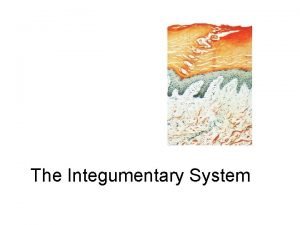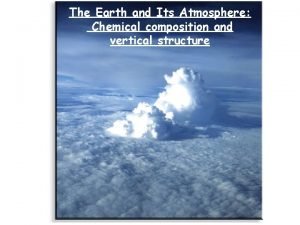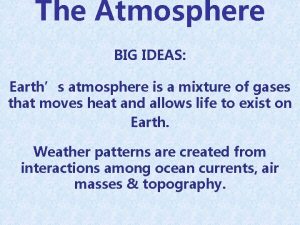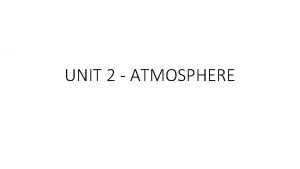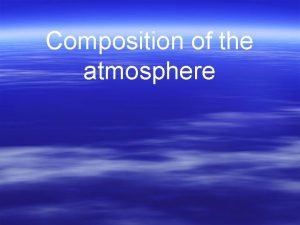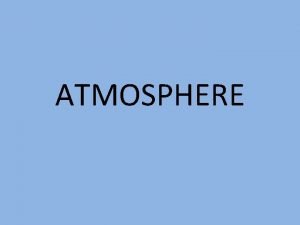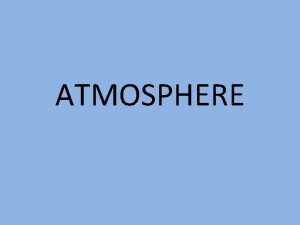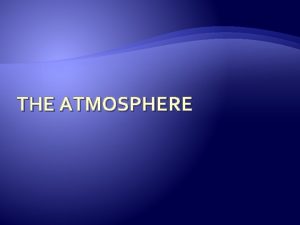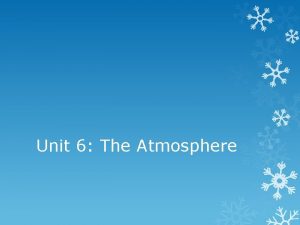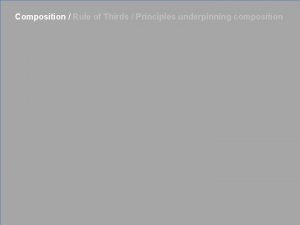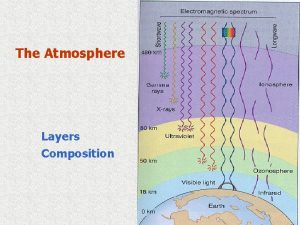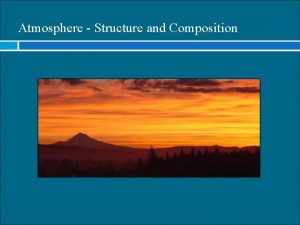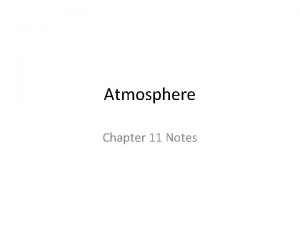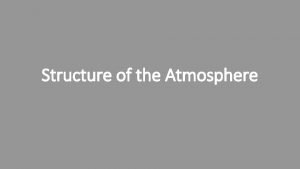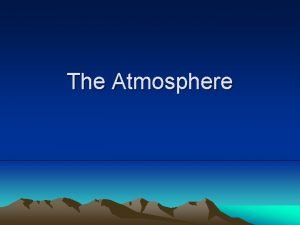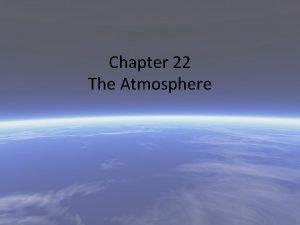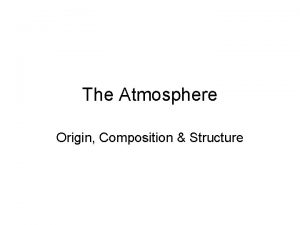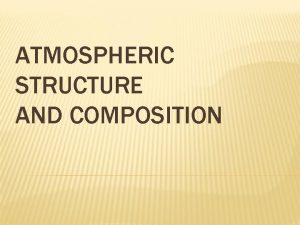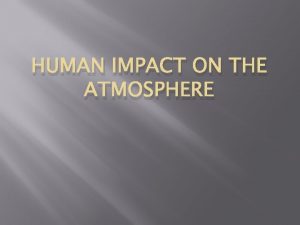UNIT 2 ATMOSPHERE ATMOSPHERE COMPOSITION THE ATMOSPHERE INSULATES



































- Slides: 35

UNIT 2 - ATMOSPHERE

ATMOSPHERE = COMPOSITION THE ATMOSPHERE INSULATES THE EARTH’S SURFACE-- IT IS HELD CLOSE TO THE EARTH BY GRAVITY

The atmosphere’s four layers • Atmospheric layers have different • Temperatures • Densities • Composition

ATMOSPHERE LAYERS

TROPOSPHERE: *Nearest to Earth’s surface ( active area that contains the air we breathe) *extends to 18 km above surface ( 7 miles) *weather occurs here (has clouds) *densest layer ( makes up about 75% of atmosphere’s mass) *temperature decreases as altitude increases (to – 60 ° C) *thin layer compare to the others *lowest altitude has the warmest portion due to surface radiated heat *Tropopause is the buffer zone between the Troposphere and next layer

STRATOSPHERE *above the troposphere *11 – 50 km above surface (7 – 31 miles) * commercial air planes travel here *lower part cold (-57° C) and has strong winds as part of a circulation pattern *has a thin Ozone Layer----(18 – 30 km/10 – 19 mi)--- protects Earth from harmful UV radiation *temperature increases as altitude increases due to absorption of UV heat by Ozone layer *stratopause: the buffer zone between stratosphere and next layer

MESOSPHERE *middle layer *extending from 50 to 90 km (31 – 60 mi) *coldest layer with low air pressure *temperatures decrease with altitude (-101° C ) *meteors burn here (shooting stars)

THERMOSPHERE *at about 100 km and above *space shuttle orbits here *also known as IONOSPHERE *temperature can reach 2000 ° C *temperature increases with altitude due to gamma rays, x-rays, & UV radiation converting atoms into IONS (called IONIZATION) *this layer reflects radiowaves which allow for long distance radio communication *the accumulation of IONS produce red and green lights known as Aurora Borealis (northern lights) and Aurora Australis (southern lights) https: //www. youtube. com/watch? v=e. JV_wl. Cm 6 m

Atmospheric properties • Atmospheric pressure = the force per unit area produced by a column of air • Relative humidity = the ratio of water vapor air contains to the amount it could contain at a given temperature • Temperature = varies with location and time Atmospheric pressure decreases with altitude

AIR PRESSURE: the atmosphere is pulled down by gravity *Most of the mass of the Earth’s atmosphere is within the lower 30 km. (gets denser at surface) *measured in (h. PA) = inches of mercury Weather forecasters measure air pressure with a barometer. Barometers are used to measure the current air pressure at a particular location in "inches of mercury" or in "millibars" (mb). A measurement of 29. 92 inches of mercury is equivalent to 1013. 25 millibars. https: //www. youtube. com/watch? v=x. JHJs. A 7 b. YGc

Air masses have different pressures • High-pressure system = air that descends because it is cool • It spreads outward as it nears the ground • Brings fair weather • Low-pressure system = warm air rises and draws air inward toward the center of low pressure • Rising air expands and cools • It brings clouds and precipitation

HIGH AND LOW PRESSURE * HIGH PRESSURE forms at the surface = fair weather * LOW PRESSURE at the surface = stormy weather https: //www. youtube. com/watch? v=rj. ODDPznq. NM H L ***Know how to read the basics of a Weather Map https: //www. yo utube. com/watc h? v=Gk. E 3 F 5 Au. W BQ

Air masses produce weather • Front = the boundary between air masses that differ in temperature, moisture, and density • Warm front = boundary where warm, moist air replaces colder, drier air • Cold front = where colder, drier air displaces warmer, moister air Warm fronts produce light rain Cold fronts produce thunderstorms

WEATHER VS CLIMATE WEATHER: the state of the atmosphere at a particular place at a particular time *short term. * the physical properties of weather that are measured : (wind speed, wind direction, temperature, air pressure, humidity, precipitation) CLIMATE: the average weather conditions at a particular place over a long period of time ( over 30 years ) * EX. Phoenix climate is Hot and dry

CLIMATE EVIDENCE: • • GLACIER GAS BUBBLES TREE RINGS DEEP ICE CORE SAMPLES https: //www. youtube. com/ watch? v=Atp 412 HEHDY

NOAA = National Oceanic & Atmosphere Administration METEOROLOGISTS = STUDY WEATHER AND CLIMATE WHY DO WE HAVE WEATHER? ? Weather results from the uneven warming of the Earth by the Sun.

Solar energy heats the atmosphere • Energy from the sun: • Heats and moves air • Creates seasons • Influences weather and climate • Solar radiation is highest near the equator The sun’s energy heats the atmosphere, drives air circulation, and helps determine weather, climate, and the seasons.

Solar energy creates seasons • Because the Earth is tilted 23. 5 degrees, each hemisphere tilts toward the sun for half the year resulting in seasons Degree tilt June 21 Summer Solstice March 21 SPRING/VERNAL EQUINOX DECEMBER 21 WINTER SOLSTICE SEPTERMBER 21 FALL/AUTUMNAL EQUINOX

SOLAR ENERGY TRANSFER: Radiation

Solar energy causes air to circulate • Air near Earth’s surface is warm due to conduction of solar radiation • Convective Current Circulation = • Heated air expands and becomes less dense, then rises creating a vertical current • Air cools with altitude and gets replaced with rising warm air creating a horizontal current • Cool air compresses and becomes denser, then descends creating a vertical current • Air warms at Earth’s surface and gets replaced with descending cool air creating a horizontal current • The circulation forms Density increases Convection influences weather and climate Density decreases

Wind is air moving as a result of convection currents that form due to uneven solar heating Wind flows from areas of high pressure to areas of low pressure. ANEMOMETER FOR WIND SPEED WIND VANE FOR WIND DIRECTION

CORIOLIS EFFECT https: //www. youtube. com/watch? v=dt_XJp 77 -mk https: //www. youtube. com/watch? v=i 2 mec 3 vgea. I Coriolis Effect= is the deflection of moving objects viewed from a turning frame of reference Coriolis effect causes an air motion deflection path because of the Earth’s rotation. The Earth rotates faster at the Equator than it does at the poles. This is because the Earth is wider at the Equator. *Coriolis effect explains the directional prevailing winds of the Earth

LATITUDE: the distance from the equator measured in degrees North and South of equator *high latitudes EQUATOR = 0 degrees *low latitudes NOTE: The most important factor that determines the differences in climate around the world is the distance from the Equator which affects the amount of sunlight radiation received

PREVAILING WINDS *TRADE WINDS= belts of winds between the Equator and 30° N and S latitudes. *blow from Northeast in N. Hemisphere *blow from Southeast in S. Hemisphere *WESTERLIES= belts of winds between 30° and 60° *blow from Southwest in N. Hemisphere *blow from Northwest in S. Hemisphere *EASTERLIES= belts of winds between 60° and poles. *blow from Northeast in North Pole *blow from Southeast in South Pole

HORSE LATITUDES AND DOLDRUMS HORSE LATITUDES= a belt of calm air and sea occurring in both the northern and southern hemispheres between the trade winds and the westerlies. (30° TO 35° N & S of equator) DOLDRUMS=“equatorial belt of calms”, area around the earth centered slightly north of the equator between the two belts of trade winds. (5°N TO 5° S )

CONVECTION CELLS 90 60 Ferrel cell 30 HADLEY CELLS: air cells with warm, moist air rising at the equator and cool, dry air descending at the 30 ° latitudes. Influenced by the low pressure formed between the Trade winds FERREL CELLS: air cells with cool, dry air descending at the 30 ° latitude and warm, moist air rising at the 60 ° latitude. Influenced by the high pressure formed between the Trade winds and the Westerlies. 0 30 60 90 POLAR CELLS: air cells with warm, moist air rising at the 60 ° latitude and cool, dry air sinking at 90 ° latitude. Influenced by the low pressure formed between the Westerlies and Easterlies.

JET STREAMS = high stream currents in upper troposphere https: //www. youtube. com/watch? v=huweoh. Ih_Bw Jet streams are long, narrow current of fast moving air found in the upper atmospheric levels. They are found between 10 to 14 km high in the troposphere. They blow from west to east at speeds of 240 km/h and can dip northward or southward depending on atmospheric conditions. Air temperature differences drive the jet stream.

RAINSHADOW EFFECT A dry area on a mountain side because the mountain blocks the movement of wet air. https: //www. youtube. com/ watch? v=kja 6 ds 7 npj. U

HURRICANES https: //www. youtube. com/watch? v=c 2 XVZGp. Mw. S 4 *Hurricanes begin over warm oceans where trade winds meet and warm up *Thunderstorms form and move in a circular motion which makes it pick up moisture and heat energy. *The eye (center) is where there is descending air and low pressure. *Wind circles around the eye counter clockwise in the N. Hemisphere– it will circle clockwise in the S. Hemisphere NOTE: Typhoons are hurricanes over the West Pacific Ocean and Cyclones are hurricanes in the Indian Ocean

HURRICANE CATEGORIES https: //www. youtube. com/watch? v=n. IWz 60 XMli. E

TORNADOES https: //www. youtube. com/watch? v=7 b. HSS 1 Im. FQI *Tornadoes form when speeding cold fronts smash into warm humid air forming a convection of temperature and winds *Winds in tornadoes can reach speeds of over 250 km/h *the center of the tornado has low pressure *Tornadoes are un-predicatable

TORNADO CATEGORIES H vs T https: //www. youtu be. com/watch? v= W 0 Lsk. Be_Qf. A movie https: //www. yout ube. com/watch? v =7 qym 7 b-qvk. E

THE EFFECTS OF OCEAN CURRENTS AND CLIMATE *Ocean Currents are large volumes of water flowing in a certain direction. *Wind driven currents are called Surface currents *Vertical currents driven by density that sink and rise are called Density Currents *Coriolis Effect will influence the direction of currents differently in the hemisphere: Example: a right curve (clockwise) in the Northern Hemisphere Example: a left curve (counterclockwise) in the Southern Hemisphere *Prevailing winds influence the formation and direction of ocean currents *Currents carry warm and cold temperatures horizontally across the ocean surface to different parts of the world.

THE GULF STREAM - THE GREAT OCEAN CONVEYOR BELT • THE GULF STREAM IS A LARGE CURRENT SYSTEM THAT AFFECTS THE WEATHER AND CLIMATE BY CIRCULATING THERMAL ENERGY AROUND THE EARTH • HIGH SALINITY WATER COOLS AND SINKS IN THE NORTH ATLANTIC THEN DIFFERENT CURRENTS MOVE THIS COOL WATER TOWARDS THE SOUTHERN HEMISPHERE • THE GULF STREAM THEN WARMS AT THE EQUATOR RISES IN THE INDIAN OCEAN AND PACIFIC OCEAN BRINGING COOLER TEMPERATURES TO THAT REGION • WARM SURFACE CURRENTS CIRCULATE BACK TO ATLANTIC OCEAN BRINGING WARMER TEMPERTURES TO THE NORTHERN REGIONS OF THE GLOBE

https: //www. youtube. com /watch? v=Uu Gr. Bh. K 2 c 7 U
 This insulates our earth from the deep cold of space
This insulates our earth from the deep cold of space What protects cushions and insulates the skin
What protects cushions and insulates the skin Structure of atmosphere
Structure of atmosphere Atmosphere composition
Atmosphere composition Atmosphere ideas
Atmosphere ideas Unit 6 review questions
Unit 6 review questions Basic paragraph
Basic paragraph Basic unit of poetry
Basic unit of poetry Hình ảnh bộ gõ cơ thể búng tay
Hình ảnh bộ gõ cơ thể búng tay Ng-html
Ng-html Bổ thể
Bổ thể Tỉ lệ cơ thể trẻ em
Tỉ lệ cơ thể trẻ em Gấu đi như thế nào
Gấu đi như thế nào Chụp tư thế worms-breton
Chụp tư thế worms-breton Hát lên người ơi
Hát lên người ơi Các môn thể thao bắt đầu bằng từ đua
Các môn thể thao bắt đầu bằng từ đua Thế nào là hệ số cao nhất
Thế nào là hệ số cao nhất Các châu lục và đại dương trên thế giới
Các châu lục và đại dương trên thế giới Công của trọng lực
Công của trọng lực Trời xanh đây là của chúng ta thể thơ
Trời xanh đây là của chúng ta thể thơ Cách giải mật thư tọa độ
Cách giải mật thư tọa độ Làm thế nào để 102-1=99
Làm thế nào để 102-1=99 Phản ứng thế ankan
Phản ứng thế ankan Các châu lục và đại dương trên thế giới
Các châu lục và đại dương trên thế giới Thể thơ truyền thống
Thể thơ truyền thống Quá trình desamine hóa có thể tạo ra
Quá trình desamine hóa có thể tạo ra Một số thể thơ truyền thống
Một số thể thơ truyền thống Cái miệng nó xinh thế chỉ nói điều hay thôi
Cái miệng nó xinh thế chỉ nói điều hay thôi Vẽ hình chiếu vuông góc của vật thể sau
Vẽ hình chiếu vuông góc của vật thể sau Biện pháp chống mỏi cơ
Biện pháp chống mỏi cơ đặc điểm cơ thể của người tối cổ
đặc điểm cơ thể của người tối cổ Thế nào là giọng cùng tên? *
Thế nào là giọng cùng tên? * Vẽ hình chiếu đứng bằng cạnh của vật thể
Vẽ hình chiếu đứng bằng cạnh của vật thể Tia chieu sa te
Tia chieu sa te Thẻ vin
Thẻ vin đại từ thay thế
đại từ thay thế

